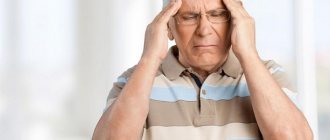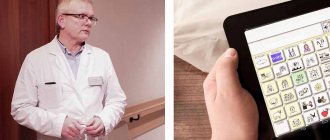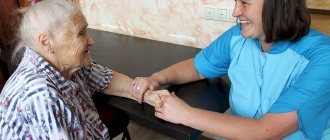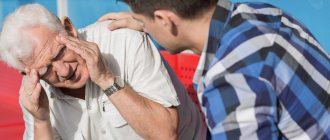Hemorrhagic stroke is a rupture of cerebral vessels and hemorrhage in brain tissue. Depending on the localization and extent of the process, the prognosis of the disease is determined. Hemorrhagic stroke occurs less frequently than ischemic stroke, but the prognosis of the disease is more unfavorable.
The Yusupov Hospital treats patients with strokes and provides emergency care with the patient being transported to the intensive care unit. In the hospital, the patient will be examined using innovative equipment and will receive effective treatment using minimally invasive neurosurgery methods, the latest developments in the field of stroke treatment, and modern medications. The hospital provides comfortable rooms, dietary meals, and doctors create an individual treatment and rehabilitation program.
Types of hemorrhagic stroke
The effectiveness of stroke treatment depends on timely medical care. In hemorrhagic stroke, symptoms depend on the location of the injury. There are several types of hemorrhagic stroke:
- Intraventricular stroke - characterized by rupture of blood vessels and breakthrough of blood into the ventricles of the brain. The brain tissue becomes saturated with blood or hematomas form in the ventricles of the brain. Such a stroke most often ends in the death of the patient on the 2nd or 3rd day.
- Parenchymal stroke - hemorrhage occurs in the substance of the brain, a hematoma can form or the nerve tissues of the brain become saturated with blood, as a result of such a stroke a severe neurological deficit is formed.
- Subarachnoid stroke - hemorrhage occurs in the cavity between the arachnoid and pia mater of the brain.
- Mixed hemorrhages - bleeding is accompanied by changes that are characteristic of different types of strokes.
Causes
Hemorrhagic stroke is poorly diagnosed, although the causes and mechanism of its development are well studied. Various factors can provoke the development of hemorrhoidal stroke:
- Hypertension, arterial hypertension.
- Vascular aneurysm.
- Long-term use of anticoagulants.
- Diseases of the brain, spinal cord, cardiovascular system, diabetes.
- Congenital vascular defects.
- Blood diseases.
- Systemic diseases.
- Kidney and liver diseases.
- Alcoholism, drug addiction, tobacco addiction.
- Obesity.
- Stress.
- Hard physical labor.
- Hereditary predisposition.
A persistent increase in blood pressure leads to the formation of fibrinoid-hyaline necrosis of the walls of arterial vessels and can cause rupture of the walls of the aneurysm and the development of bleeding. The hematoma compresses the surrounding brain tissue, causing brain swelling. Blood from ruptured vessels can permeate the nerve tissue of the brain or, under pressure, break into the ventricles of the brain, the subarachnoid space.
Symptoms of hemorrhagic stroke
Subarachnoid hemorrhage is accompanied by severe headache, vomiting, convulsions may begin, consciousness is impaired, Terson syndrome is observed, and meningeal symptoms appear. Parenchymal stroke is characterized by unexpectedly occurring severe headache, pallor or redness of the face, asymmetry of facial features, impaired coordination of movement, impaired respiratory function, and agitation. Ventricular stroke, the most severe form of the disease, is characterized by rapid deterioration of the patient's condition; bloody vomiting, loss of consciousness, fever, convulsions, and coma may occur. Ventricular stroke most often leads to the death of the patient. In most cases, hemorrhagic stroke occurs during the daytime, and the patient suddenly loses consciousness.
At the first examination, doctors note a change in complexion, high blood pressure, impaired respiratory function, slow pulse, decreased muscle tone, and tendon reflexes. Such symptoms are characteristic of the first hours after a stroke, then an increase in muscle tone and tendon reflexes occurs, the function of the pelvic organs is disrupted, the condition worsens, and the patient may fall into a coma.
Make an appointment
Difference between hemorrhagic stroke and ischemic stroke
Strokes are characterized by the same symptoms, but have different causes of pathology. Hemorrhagic stroke has a more unfavorable prognosis and is characterized by the development of various severe disorders. In ischemic stroke, a favorable prognosis depends on the degree of brain damage. All types of strokes are characterized by the following disorders:
- Loss of speech.
- Paralysis of the body and limbs.
- Impaired sensitivity.
- Visual impairment or complete loss.
- Loss of coordination.
- Partial or complete hearing loss.
- Disorder of the function of the cerebral cortex.
- High blood pressure.
The consequences of a stroke depend on the location and extent of the brain lesion. Hemorrhagic stroke begins acutely, the disease progresses rapidly, and coma may develop within the first minutes or several hours. With hemorrhagic stroke, symptoms appear earlier than with ischemic stroke, they are more pronounced.
HEMORRHAGIC STROKE: FEATURES OF PATIENT REHABILITATION
Hemorrhagic stroke is hemorrhage from the affected vessel directly into the brain tissue, the space under the arachnoid membrane of the brain, or the cavity of the cerebral ventricle. Currently, hemorrhagic strokes most often occur between the ages of 35 and 60 years, somewhat less often in women - that is, there is an ongoing “rejuvenation” of the disease.
As with the vast majority of diseases, rehabilitation is very important for this pathology. Rehabilitation is understood as a set of measures aimed at restoring the patient’s personal integrity, professional abilities, and the adaptation of a person who has suffered a stroke to society.
In general, with a hemorrhagic version of a stroke - compared to an ischemic one - rehabilitation requires more effort on the part of both medical personnel and the patient’s relatives, as well as from the patient himself. The duration of restoration measures is usually much longer, and their results are somewhat worse. In case of hemorrhagic stroke, rehabilitation begins almost in the acute period and sometimes continues for life. Based on many years of research and observation, it is generally accepted that the period of active recovery lasts up to one and a half years, and actions aimed at accelerating this process are most effective during the first year. Of course, factors such as the patient’s age, the presence of concomitant diseases and risk factors, the nosological nature of the disease (atherosclerosis, arterial hypertension, cerebral aneurysm), the extent of brain tissue damage, and the speed of initiation of treatment from the appearance of the first signs of an acute stroke condition are important.
Unlike an ischemic stroke, with a hemorrhagic stroke, the nerve cells of the affected parts of the brain almost completely die and cannot take on the load even after several years. Hemorrhages into the ventricles of the brain sometimes lead to the persistence of residual effects in the form of intracranial hypertension, which is often very difficult to completely cope with. Approximately three-quarters of patients who suffer a hemorrhagic stroke are left with significant impairment for a long period, and sometimes for the rest of their lives.
The main principles of rehabilitation for this disease, as for many others, are its complexity with the simultaneous use of several techniques, continuity, gradualness and focus on specific syndromes (visible pathological manifestations).
The most common and significant possible disorders are speech problems, sensory disturbances and paralysis of the limbs, changes in thinking processes; swallowing disorder. In this regard, personal interaction with the patient is somewhat more important than in ischemic stroke. Restoring memory and mental activity (including medication) becomes more important.
Since speech disorders are more pronounced and persist longer, long-term persistent sessions with a speech therapist, aphasiologist, and sometimes with a psychologist are necessary. A greater role than in ischemic stroke is given to diet and lifestyle corrections. With physical inactivity, this is primarily dosed physical activity. The alternation of tonic and relaxing exercises, training of fine motor skills - precise movements of the hand - are very important. And finally, a more specific account of contraindications is needed when prescribing physical therapy and massage (presence of a blood clot, heart rhythm disturbance).
According to one study, survival rates after stroke increase when antidepressants are prescribed. The fact is that depressive (psychosomatic, that is, based on a physical illness) syndrome - by itself or in combination with possible pain - has a negative impact on the general condition of a person. In addition to prescribing medications, stress is now combated with specially selected music and even laughter. Art therapy – “treatment with art” – is also widely used. It may include coloring various blanks, reproducing paintings, and even conducting familiar works to an audio recording.
The range of rehabilitation measures is now quite large - for example, rehabilitation methods using robotic technologies have recently been developed and are being implemented.
Interestingly, in some cases, during recovery, the nature of the abilities existing before the illness changes. Thus, the outstanding composer A. Schnittke noted that after his first stroke his nature of composing music changed; it “went like a stream,” as those who studied his work wrote, although significant speech and motor impairments remained.
Of course, everything listed here is general in nature. We must not forget that it is impossible to cope with the consequences of the disease on your own - in each specific situation, long-term work with the patient by several specialists is necessary.
To date, despite the severity of the consequences of hemorrhagic stroke, some success has been achieved in overcoming this condition. And we must remember that sometimes even complete recovery becomes not a myth, but a reality.
Author: Yuri NIKULIN,
doctor, graduated from Moscow State Medical University named after. A.I. Evdokimova, experience in practical medicine – 25 years.
Treatment after a stroke
A patient with a hemorrhagic stroke should receive first aid. The patient is placed on the bed, clothes are unbuttoned to make breathing easier, and a window is opened to allow fresh air to enter. The patient's head should be higher than the body level. The patient should measure blood pressure and pulse, monitor breathing in case of loss of consciousness and, if necessary, carry out resuscitation measures. The main task of doctors in case of hemorrhagic stroke is to stop bleeding, maintain respiratory function, the functioning of the cardiovascular system, and relieve cerebral edema.
In case of extensive hemorrhage in the brain, neurosurgical microtechnical operations are used - the hematoma is removed in order to reduce the pressure on the brain tissue and prevent the development of cerebral edema. Surgery for hemorrhagic stroke is performed strictly according to indications. Painkillers are prescribed to reduce headaches. If the cause of a hemorrhagic stroke was an aneurysm, doctors perform an operation and prescribe hemostatic drugs to stop the bleeding. Often, subarachnoid stroke is accompanied by vasoconstriction (secondary vasospasm) and the development of ischemic stroke. In this case, calcium channel blockers are prescribed to prevent narrowing and spasm of blood vessels.
Rehabilitation after stroke
After being hospitalized for a stroke, many patients are left with problems with physical, speech, and mental function. However, in many cases the brain has great potential for recovery.
The rehabilitation process plays a critical role in helping patients regain lost skills so that the patient can regain independence and maintain quality of life. With active, timely, painstaking daily work, these prospects for improving the condition can become even better. Rehabilitation can continue for years after a stroke, but for many patients it occurs most quickly in the first year after the stroke.
This is why it is important for medical specialists - neurologists, physiotherapists, speech therapists and others - to begin working with the victim as soon as possible after a stroke.
A multifunctional medical center is able to offer not only the help of highly qualified specialists, but also has a modern diagnostic base for monitoring the patient’s condition during rehabilitation after a stroke in Moscow, as well as assessing the risks of developing a recurrent stroke, since the proportion of recurrent strokes is high and leads to increased disability or death outcome.
Consequences of a stroke
People come to the clinic for rehabilitation of the consequences of both ischemic and hemorrhagic types of stroke. Depending on which area of the brain is damaged, a stroke can cause the following types of dysfunction:
- Paralysis, paresis
- Pain or loss of sensation
- Problems with speech recognition and articulation
- Cognitive disorders (thinking, memory)
- Emotional disorders
- exacerbation of diseases of the cardiovascular, respiratory, excretory systems, etc.
- Bedsores and their complications in the absence of proper care for a bedridden patient
- swallowing disorders (dysphagia), etc.
Recovery stages
Conventionally, the rehabilitation period after a stroke is divided into several stages:
During the acute period
the main task is to maintain the basic functions of the body and preserve the life of the patient in the hospital.
Early recovery period
in the first six months after a stroke, it is especially important to restore the patient’s motor skills and cognitive abilities - passive gymnastics, massage, breathing exercises and speech restoration classes.
Late recovery period
from six months to a year is characterized by daily supportive sessions with specialists.
Remote period
after 1 year allows one to judge the results achieved in previous periods and the degree of restoration of the functions of dead brain cells.
At each stage, continuity and regularity in the organization of rehabilitation measures are important.
What to do after a stroke - types of rehabilitation
Medication correction
is selected by the attending physician in the hospital and can then be adjusted by the supervising neurologist. Drugs are used to help relieve symptoms - analgesics, muscle relaxants, sedatives, as well as drugs that help restore and maintain current processes in the patient's body - improve cerebral blood supply, activate metabolic processes, restore brain cells, etc.
Physiotherapy
promotes positive dynamics in restoring processes in the brain and preventing the worsening of negative consequences.
In complex therapy, the best results are shown by electrophoresis with drugs; circulatory insufficiency of the affected brain is well eliminated with the help of regular courses of electrical myostimulation; both darsonvalization and magnetic therapy are used for the affected limbs.
Acupuncture
Safely and effectively helps launch self-healing and self-regulation processes. The advantage is that the procedures can be performed even on bedridden patients.
Neuropsychologist and psychologist
with the help of certain techniques they can relieve symptoms of anxiety and apathy in the patient, and adjust the psychological mood.
Massage
after a stroke, it is indicated in the absence of complications for patients with ischemic stroke, starting from the early recovery period.
Physiotherapy
(exercise therapy) promotes the recovery process, the development of new conditioned reflex connections, including compensatory mechanisms for functional restoration.
Hirudotherapy
prescribed only for ischemic stroke. Substances contained in the saliva of leeches contribute to the rapid restoration of brain vessels, strengthening the walls of blood vessels, which prevents recurrent strokes.
Factors influencing the success of rehabilitation
Several factors play a role in successful rehabilitation after stroke:
- The degree of damage to brain tissue. The smaller the damage, the more dynamic the recovery.
- Patient's emotional state. A person's positive attitude after a stroke can help them cope with difficulties and focus on getting better.
- Support from relatives. Maximum support for the family is to provide not only proper care, but also reassure the patient of his need and importance for the family.
- Time before the start of rehabilitation. Rehabilitation should begin as soon as possible after a stroke. Even simple tasks such as exercising paralyzed muscles and turning a person over in bed should begin very soon after a stroke. Stroke rehabilitation is most successful when it is a team effort. The stroke patient and family must work with their physician and other rehabilitation specialists.
Stroke does not go away without leaving its mark, and rehabilitation is the key to achieving small victories along the road to recovery.
Advantages of visiting the Miracle Doctor clinic
24-hour hospital
Preventive, therapeutic and rehabilitation procedures can be carried out in comfortable rooms.
Comprehensive examination
A full range of tests, vascular ultrasound, CT and CT angiography, MRI, ECHO-CG, Holter ECG monitoring and other studies are performed immediately after the appointment.
Interdisciplinary approach
Highly qualified clinic specialists (cardiologists, neurologists, therapists, endocrinologists) can interact on site, which allows achieving results comparable to the effect of a patient being in a rehabilitation center after a stroke.
Individual approach
Each stroke case is unique, so all types of rehabilitation are selected individually.
Consequences
The consequences of a hemorrhagic stroke can bother the patient for the rest of his life. Depending on the severity of the disorders, recovery occurs; the most severe condition is in patients with extensive hemorrhagic stroke. Depending on which hemisphere of the brain is affected, the consequences of cerebral hemorrhage are observed. Hemorrhagic stroke of the right hemisphere of the brain:
- Partial or complete loss of vision.
- Disorders of urination and defecation.
- Paresis or paralysis of the body, decreased sensitivity of the left half of the body.
- Development of mental disorders.
A stroke to the left hemisphere of the brain causes paralysis on the right side of the body. When hemorrhage occurs in the area of the brain stem or cerebellum, loss of sensitivity occurs, the patient cannot swallow or speak, partial or complete loss of hearing in the right ear occurs, vision is impaired, coordination of movements is impaired, the patient cannot make unilateral or bilateral voluntary movements. Often the consequence of a hemorrhagic stroke is dementia (dementia), which develops gradually.
The importance of the first stage of recovery
It is at the early stage of rehabilitation after a hemorrhagic stroke that the main objectives of the entire treatment are realized:
- Improvement or normalization of lost functions.
- Psychological, social adaptation of the patient.
- Prevention of complications and recurrent hemorrhage.
The set of procedures and their intensity are determined by the doctor. Most often, in rehabilitation centers in Moscow after strokes, a special complex of physical therapy, massage, physiotherapy, medications, and work with a psychologist are prescribed.
It is important to monitor your diet to ensure that your diet contains all the necessary vitamins and minerals. The age and physiological characteristics of the patient with the severity of the consequences of cerebral hemorrhage must be taken into account.
It is almost impossible to carry out a complete recovery at home. You will have to constantly transport the patient to the hospital for procedures. It is easier to immediately go to a rehabilitation center, where a person is always under the supervision of doctors and medical staff.
Rehabilitation of hemorrhagic stroke
Rehabilitation of the patient in the first 6-12 months consists of maintaining his vital functions and restoring lost abilities. During this period, when the patient has lost motor functions, the risk of bedsores and congestion increases. The patient is turned several times a day, the position of the body is changed, hygienic procedures are carried out, massage is carried out, the instructor engages in physical therapy exercises with the patient. During this period of time, the patient’s condition is monitored by several doctors - a therapist, a neurologist, a cardiologist and a psychologist. Rehabilitation measures are aimed at improving the patient’s quality of life and restoring lost functions.
Forecast
The prognosis for hemorrhagic stroke depends on the severity of brain damage and the time of seeking first aid. If the stroke was not extensive and did not affect the vital centers of the brain, timely assistance was provided - there is a chance to return to normal life. It is impossible to predict the patient’s life expectancy - the prognosis depends on many factors:
- Patient's age.
- Severity of brain damage.
- Concomitant diseases.
According to statistics, more than 30% of patients die within a few weeks after a stroke, more than half of patients die within a year, and more than 60% of patients become disabled. No more than 20% of patients can recover completely within a few years.
Effective rehabilitation programs have been developed and tested at the Yusupov Hospital. The recovery process after a hemorrhagic stroke is unpredictable, lengthy and difficult. You can get advice on the treatment and rehabilitation of a patient by calling the hospital.
Make an appointment
The procedure for rehabilitation after hemorrhagic stroke
Unfortunately, stroke cannot be completely cured. Today, medicine can only offer rehabilitation therapy to restore the body’s functions as much as possible and adapt the patient to new conditions.
Rehabilitation after a hemorrhagic stroke includes learning all everyday skills from scratch, restoring muscle tone and general activity of the body. If you use an integrated approach to therapy and support the patient at home, you can recover from a hemorrhagic stroke quite quickly. Therapy should be carried out continuously, actively, but without overloading the patient.
It is best to carry out rehabilitation activities within a period of up to six months after a stroke; according to other sources, up to 12 months. But even if good results are achieved, it is recommended to carry out additional rehabilitation measures for at least 3 years - this will help consolidate skills and improve the general condition of the patient.







